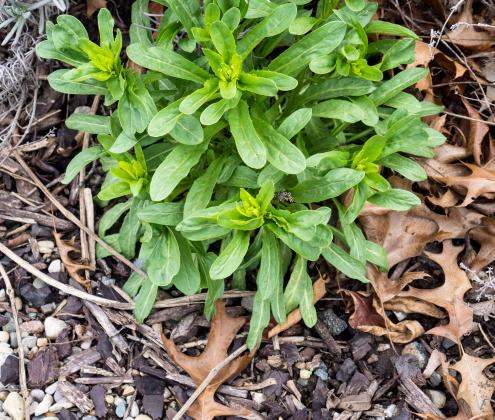Thlaspi arvense - Future biofuel with no food-versus-fuel issue
Thlaspi arvense, field pennycress, is found on every continent with debate about Antarctica. It is in the mustard family, Brassicaceae, with the same characteristics as other family members such as cabbage, kale, etc. Leaves and stem of family members have a pungent mustard odor when crushed. Flowers, white or yellow, have four petals in the pattern of a cross with 6 stamens, 4 tall and 2 short. Finding these characteristics means you have found a mustard. Pennycress grows in Grimes County as a winter annual first seen as a basal rosette of spatula-shaped alternate oblong leaves on a ribbed stem. They are toothed or wavy, 1 to 4 inches long and up to 1 inch wide. They clasp the stem with top leaves clasping more than the ones below. Clusters of white flowers are at the top of the stem. Seedheads are ⅓ to ½ inch coin-shaped pods with a notch at the top. The plant is named for an old English penny. Farmers and ranchers dislike pennycress because it competes with crops and taints the flavor of milk and meat if animals eat it. Pennycress is edible, prepared as other mustards. Seeds can be sprouted or ground as a spice. Medicinally it is an antibacterial, anti-inflammatory, etc. More information is at the Native American Ethnobotany Database at naeb.brit.org. T. arvense is in the Food and Drug Administration Poisonous Plant Database at fda.gov.
There is interest in using pennycress as a biofuel, a renewable energy source made from plants, algae, etc. Fossil fuels such as petroleum, coal and natural gas are not renewable. Some say biofuels take land needed for food crops such as soybeans. Pennycress grows during winter and spring months with harvest in May to June. Soybeans, usually planted from May to July, could grow on the same land. There would be no food-versus- fuel issue.
Pennycress has not been domesticated. Most research is about how to remove it. More information is needed about its genetics, harvest date, etc. The U.S. Navy, Air Force, etc. are interested in developing plants for renewable diesel and aviation fuel. Following are articles.
• “Field Pennycress (Thlaspi arvense L.) Oil: A Promising Source of Biodiesel”. The National Institutes of Health, NIH, ncbi.nlm.nih. gov.
• “Technologies enabling rapid crop improvements for sustainable agriculture: example pennycress (Thlaspi arvense L.)”. NIH.
• “Aviation Fueling: A Cleaner, Greener Approach”. Defense Technical Information Center, apps.dtic.mil. “Biofuels sourced from ... ‘weeds’ … have the capacity to be drop-in fuel replacements for petroleum fuels. Biojet fuels from such sources solve the aviation CO2 emissions issue and do not compete with food or freshwater needs.”
• “Thlaspi arvense (Pennycress) as a biodiesel in a one year-two crop rotation with soybean”. U.S. Department of Agriculture, ars.usda. gov. “The short term answer to biodiesel has always been soybean. Unfortunately, soybean oil has several shortcomings in its effort to supply the U.S. market. First, and foremost, is the fact that if all current soybean oil was converted to biodiesel, we could only supply 12% of the U.S. diesel demand.”
Deborah Richardson is a freelance reporter for The Examiner with a fondness for flora in its natural setting.




